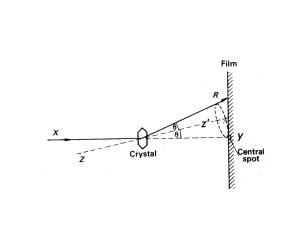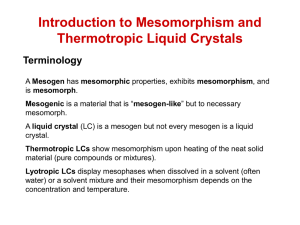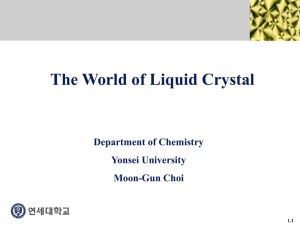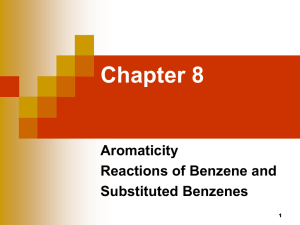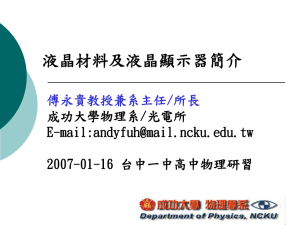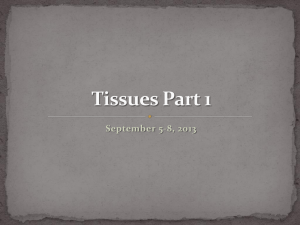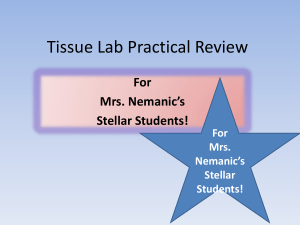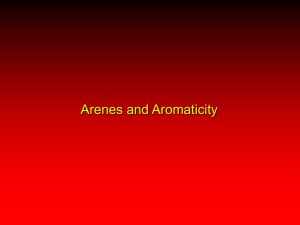Lecture 03 - Chemistry Research
advertisement
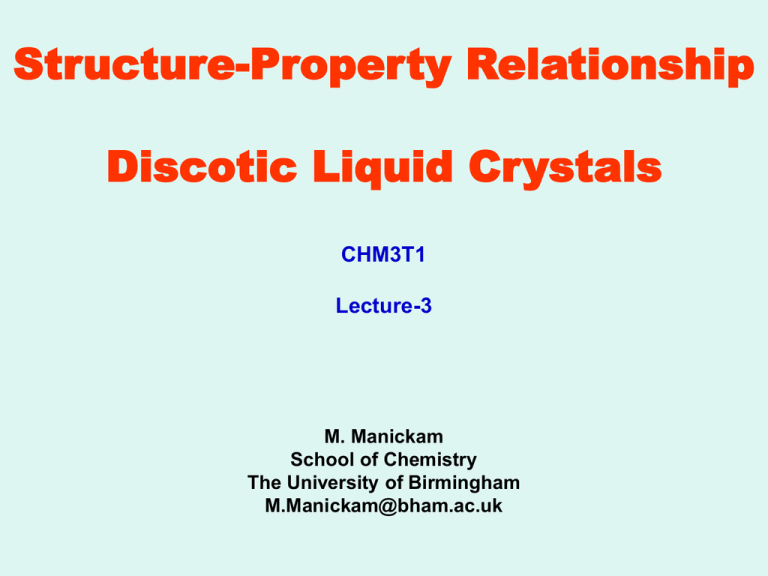
Structure-Property Relationship Discotic Liquid Crystals CHM3T1 Lecture-3 M. Manickam School of Chemistry The University of Birmingham M.Manickam@bham.ac.uk Outline of Lecture Introduction Structure-Property Relationship of Discotic LCs Synthesis of Discotic LCs Final comments Learning Objectives After completing this lecture you should have an understanding of, and be able to demonstrate, the following terms, ideas and methods. Be aware of the fundamental principles and general structures of Discotic Lcs Understand different types of molecular arrangement within columns Understand the hexagonal columnar phase How do the different types of cores influence the mesophases? How to design and synthesis discotic liquid crystalline materials? Nomenclature Dho: discotic hexagonal ordered phase Dhd: discotic hexagonal disordered phase Drd: discotic rectangular disordered phase Dob.d: oblique n: director ND: nematic discotic phase Colh: hexagonal discotic Types of Liquid Crystals Liquid crystals Lyotropic Calamitic Thermotropic Polycatenar Nematic (N) Smectic (S) Discotic Banana-shaped Nematic Discotic(ND) Columnar (Col) Discotic LCs Similarly to the calamitic LCs, discotic LCs possess a general structure comprising a planar (usually aromatic) central rigid core surrounded by a flexible periphery, represented mostly by pendant chains (usually four, six, or eight), as illustrated in the cartoon representation in figure below. As can be seen, the molecular diameter (d) is much greater than the disc thickness (t), imparting the form anisotropy to the molecular structure. Cartoon representation of the general shape of discotic LCs, where d >>t Discotic LCs The existence of mesophases generated by disc-shaped molecules was theoretically in 1970 OR ROCO ROCO OR OCOR OCOR RO RO OCOR OCOR OR Benzene hexaester By Chandrasekhar 1977 First Discotic core OR Triphenylene hexaether Columnar phase 1 X10 -4cm2v-1s-1 Discotic LCs SR OR ROCO ROCO OCOR OCOR OCOR OCOR OR RO Columnar phase 1 X10 -4cm2v-1s-1 RS RS RO OR OR Benzene hexaester 1977 SR Triphenylene hexaether SR SR Triphenylene hexathioether Helicoidal phase 1 X10 -1cm2v-1s-1 Photoconductors OR OR RO RO - A new class of charge transporting materials e - e - e - e OR OR supramolecular order aromatic single crystals H-phase HHTT 10-1 Dh-phase H5T Charge Carrier mobility [cm2/Vs] 10-3 polymeric photoconductors 10-6 Greater Supramolecular Order Means Higher Charge Carrier Mobility Applications of Discotic Liquid Crystals One-dimensional conductors Columnar phases as electron transport system Photo-conducting systems One-dimensional energy transfer properties - e - e Electro luminescence - e Light emitting diodes - e Optoelectrical switching Photovoltaic Electrically tuneable cholesteric mirrors Molecular wires Classification of Discotic Mesophases Two basic types of discotic mesophases have been widely recognised, these are 1. Columnar; 2. Nematic Several different types of columnar mesophases exhibited by discotic materials; these arise because of the different symmetry classes of the two dimensional lattice of columns and the order or the disorder of the molecular stacking within the columns Molecular arrangement within Columns Symmetry group hexagonal ordered rectangular disordered oblique Dho, Dhd, Drd, Dob.d Discotic nematic phase Figure: Representation of the ND phase, where the molecules are aligned in the same orientation, with no additional positional ordering Nematic discotic (ND) is the least ordered mesophase, where the molecules have only orientational order being aligned on average with the director as illustrated in the figure. There is no positional order. Columnar phases (a) (b) (c) Representation of (a) the general structure of Col phases, where the molecules are aligned in the same orientation and, in addition, form columns, (b) representation of Colr, (c) representation of Colh Columnar (Col) phases are more ordered. Here the disc-shaped cores have a tendency to stack one on the top of another, forming columns. Arrangement of these columns into different lattice patterns gives rise to a number of columnar mesophases, namely columnar rectangular (Colr) and columnar hexagonal (Colh) in the fashion described in the above figure. A General Structural Template R OR A general structural template for discotic liquid crystals O R S O R O R Discotic Core O Se Si O O O O X (O)R * R (O)R R Discotic Cores There are more than 30 discotic cores are known Two types of cores 1. Aromatic cores 2. Alicyclic cores Linking Groups Linking groups are normally those structural units, other than a direct bond, that connect one part of a core to another Selected examples of linking groups in liquid crystals O ester X X X O Y dimethylene Y X X H X H Y X N azo Y methyleneoxy H H acetylene ethylene Y O O O cinnamate Y X N N Y H Imine (Schiff’s base) Y Some common Chains O O ester X X X Y Y O Y dimethylene methyleneoxy X Y acetylene Some common Polar Groups NO2, Cl, Br, F, OH Terminal Moieties The role of the terminal units in the generation of liquid crystal phases is still not yet fully understood. However, the long alkyl/alkoxy chains add flexibility to the rigid core structure that tends to reduce melting points and allow liquid crystal phases to be exhibited. Additionally the alkyl/alkoxy chains are believed to be responsible for stabilising the molecular orientations necessary for liquid crystals phase generation. Polar groups, do not necessarily reducing the melting points, but stabilise the molecular orientation. Physical properties are also strongly dependent upon the choice of terminal unit Discotic Cores 2 12 1 6 5 3 1 2 11 4 3 10 5 4 Benzene 9 8 6 7 Triphenylene Triphenylene isolated from the pyrolytic products of benzene. Also it was synthesized from cyclohexanone. Six peripheral for substitution Its various physical and chemical properties were studied. Benzene Discotic OC5H11 O C5H11 C5H11 O C5H11 O O O O O O O C5H11 O C5H11 C5H11O OC5H11 C5H11O OC5H11 O C5H11 O OC5H11 C 68.3 Drd 86.0 I Hexaalkanoyloxy benzene (A) (B) Six directly attached benzene rings to a central benzene ring which provides a highly conjugated central core Mesophase stability much greater than that of compound (A) C 68.0 Drd 97.0 I Hexa (alkoxyphenyl) Benzene (B) Triphenylene Discotic C 69.0 Dho 122.0 I C5H11O OC5H11 C5H11O OC5H11 C5H11O OC5H11 symmetrically substituted hexaether C 40.0 Dhd 79.0 I C8H17O OC6H13 C8H17O OC6H13 C12H25O OC12H25 unsymmetrically substituted hexaether Triphenylene core consists of three benzene rings conjugatively joined to give a plannar aromatic unit that enables six peripheral units to be symmetrically attached, and because the core is much larger than benzene, the mesomorphic tendency of such compounds is much higher. Ether showed hexagonal ordering with the molecules ordered within the columns, probably because the polar oxygens combined with the large core facilitate a very ordered packing and the absence of any bulky units allows for ordered packing within the columns. Three different sets of peripheral chains and this results of the reduction of melting point. This unsymmetrical nature of the molecular structure is no longer truly disc-like and this is the reason why the stability of the hexagonal mesophase is much reduced and why the less ordered Dhd phase is exhibited. Discotic Cores C7H15 C7H15 O O C7H15 O O C7H15 O O O O O C7H15 O O C7H15 C7H15 C7H15 C7H15 C7H15 C7H15 O C7H15 C 66.0 Drd 126.0 I Symmetrically hexasubstituted ester The ester possess higher mesophase stability than for the simple alkoxysubstituted analogues, but they exhibit a Drd phase. C 98.2 ND 131.2 I Symmetrically hexasubstituted Benzene core structure with six peripheral acetylene-linked benzene ring units attached; the incorporation of the acetylene linkages removes the steric interactions between the aryl rings and allows the rings to be twisted at 90o with respect to each other. This arrangement of benzene rings prevents the molecules from aggregating in a columnar fashion. Transition Temperature and Phase Behaviours of Triphenylenes OC10H21 b a x b y y O O Strict Effects x O O C10H21O y x x y O C10H21O b a O OC10H21 O O a OC10H21 O O a b a O x O y b y b x a OC10H21 a b x y Transition Temperatures 1 H H H H C 142 D rd 191 ND 212 I 2 CH3 CH3 H H 3 H CH3 H Compound H C 157 D hd 167 ND 182 I C 108 ND 134 I Truxene Discotic C10H21OTruxene hexaether Truxene core is even larger than the triphenylene core OC10H21 and consists of four benzene rings. C10H21O OC10H21 Three radial rings are symmetrically attached to the central ring in two ways; firstly by a conjugative single bond, and secondly through a methylene spacer that locks in an approximately planar structure by preventing inter-annular twisting. OC10H21 C10H21O C 67.0 Dho 260.0 I C9H19 O O O O O C9H19 O O C9H19 C9H19 O O C9H19 O O O C9H19 Truxene hexaester C 68.0 ND 85.0 Drd 138.0 Dho 280.0 I The mesomorphic tendency of the compouns based on the hexa-substituted truxene core is very high. Simple ether exhibits a wide-range Dho phase up to 260 0C Ester compounds exhibits an inverted phase sequence where the ND phase is exhibited at a lower temperature than the Drd and the Dho mesophases. Normally this type of behaviour relates to a changing molecular packing ability with temperature, often caused by the conformational arrangements of the peripheral chains. Phthalocyanines Discotic • Phthalocyanines have been targeted for a wide variety of applications including colour, dyes. • Electrochromics, detection of conductivity changes (sensors), N HN NH • nonlinear optic and photodynamic therapy for the destruction of cancer cells. N Phthalocyanines Discotic Phthalocyanines with eight peripheral moieties show wide-range columnar mesophases of the Dho and Dhd types. M= H2, Cu, Ni R R N R M N R N R R N R These materials are of interest because of their potential as electron carriers for use in electronic devices. This core is able to hold metal ions in the centre which is often copper or nickel. R R = alkyl, e.g., C8H17 R= alkoxy, e.g., C12H25O R= alkoxymethyl, e.g., C12H25OCH2 The metal has the effect of increasing the columnar mesophase stability, but this usually results in the materials decomposing before they reach their clearing point. This core also has eight non-peripheral sites available for substitution; such materials have been prepared and these also exhibit columnar mesophases, often of the Drd type. Unusual Discotic R= C9H19 C 53.5 D 171.5 I R R The presence of oxygens in the high polarisable central core is probably an important factor which, in part, offsets the small number of peripheral units O O This compound unusually exhibited columnar mesophase over a wide temperature range despite the presence of only four peripheral units. R R R= C7H15COO2 C 107.5 (D 95) D 127 .5 I O R R R R R R O This compund is also unusual because it exhibits columnar mesophases even though the molecular structure is not quite disc-like; again the high polarity of the oxygen units (carbonyl in this case) within the central core aid in the generation of the necessary intermolecular forces of attraction Alicyclic Discotic C5H11 O C5H11 Disc-shaped molecules can be generated from alicyclic core structures. C5H11 O C5H11 O A cyclohexane ring is a simple example and this compound shows that mesophases are exhibited by such systems. O O O C5H11 C 68.5 D 199.5 I C5H11 The transition temperatures of this compound reveal the cyclohexane core to be better at generating columnar mesophases that the analogous benzene systems. Macrocyclic Discotic Core R Phenylacetylene macrocycles Acetylene-linking units have been employed in the construction of a conjugated ring to give a discotic R architecture. R This core is not of the usual type but has a hollow centre surrounded by alternating benzene rings and acetylene-linking groups; Conventional ether and ester units have been used as R the peripheral moieties. R R= OC7H15 R C1 144 C2 168 ND 192 I R= OCOC7H15 C1 104 C2 121 ND 241 I These materials were designed to exhibit columnar mesophases that would self-organise into molecular channels which could be used for transportation of electrons in applications such as molecular wires and membranes. Discotic Oligomer OR OR RO OR RO OR O 6 6 O RO O O OR OR 6 RO O OR OR RO O O O O O OR O OR O 6 O O OR O O O 6 O O O RO OR O RO OR 6 OR It is a very large molecule that uses flexible spacers to attach peripheral triphenylene units to a central discotic core in a star-like manner. OR O O OR RO Centre triphenylene core with six peripheral triphenylene units exhibit columnar mesophases, and these are commonly called star-like liquid crystals. O OR OR Hexagonal columnar phase of this compound has been identified as hexagonal. This structures are oligomeric and could almost be considered polymeric. OR RO OR R= C5H11: g? Dh 137 I Triphenylene OR Such a large discotic compound are a recent development, and this type of architecture offer much possibility for future development. Functionalised Triphenylene Derivatives nitration monofunctionalised OR OR halogenations RO difunctionalised RO OR OR core expansion mono OH OH OH OR OR RO RO RO RO 2,6 OR RO OH OR OH OH OR OR OR OH OR OH OH RO 2,3 RO 3,6 2,7 RO OR RO trifunctionalised 2,6,10 HO RO RO OH OR OH OR OR OR OH OR RO 2,7,10 HO OR OH Precursors for dimers, oligomers, polymers and networks Direct Core Functionalisation First Synthesis of 1, 2, 3, 6, 7, 10, 11- heptaalkoxytriphenylenes OH OR RO Ceric ammonium nitrate, CH3CN RO RT, 5-10 mins, 85-90% O O OR RO RO OR OR OR OR Zn, Ac2o Et3N, Rf., 3h 90-95% OR' OR R'O RO RO OR OR DMSO, KOH, OAc OR AcO R'Br, 55oC,12h RO 80-90% RO OR OR R -C4H9 -C8H17 -C3H7 -C4H9 -C5H11 -C8H17 R' -C4H9 -C8H17 -C12H25 -C7H15 -C6H13 -C10H21 Direct Core Functionalisation Functionalisation of Nitro Group OR OR O2N OR OR OR O2N RO RO HNO3 DCM-CH3NO2 RO RO HNO3 DCM-CH3NO2 RO OR HNO3 DCM-CH3NO2 OR O2N NO 2 RO NO 2 OR OR THF-MeOH NiCl2.6H2O NaBH4 OR OR OR OR OR OR H2N OR THF-MeOH NiCl2.6H2O NaBH4 RO RO NO 2 RO RO OR OR OR OR THF-MeOH NiCl2.6H2O NaBH4 DCM-AcOH NaNO2 OR OR RO H2N OR N OR N H2N OR RO RO OR RO RO NH 2 RO OR OR OR OR NH 2 NH 2 OR OR R = C4H9 to C7H15 Literature Method FeCl3 / Organic Solvent / Acid Method OR OR OR FeCl3, DCM conc.H2SO4 RO OR 50-75% RO OR OR Advantages - Good yield Limitations - Acid needed Not easy purification Side products New Method Oxidative Trimerisation of o-Dialkoxybenzene to Hexaalkoxytriphenylene Molybdenum (V) chloride as a novel Reagent Symmetrically Substituted Hexaalkoxytriphenylenes OR OH OH RBr, DMSO KOH OR OR OR MoCl5, DCM r.t., 20min RO 74-95% RO R = CH3 to C10H21 OR OR Unsymmetrical and Monofunctionalised Triphenylenes OH RBr, KOH OR OH DMSO OR RO OR I I2, con.H2SO4 HIO3 H2O, AcOH RO Cu OR Advantages: OR OR MoCl5,CH2Cl2,RT,30min no Acid 60-90% No acid Easy purification MoCl5,CH2Cl2,RT,30min con.H2SO4 50-70% High yield 74-95% OR' OH OR OR OR OR Selective derivatisation OR OR OH OR' RO OR OR RO RO RO RO RO RO OR OR Unsymmetrical OR OR OR OR mono OR hepta Organometallic Method OR RO RO RO + ZnX X1 Y1 Pd2 (dba) Y1 X2 Y2 PPh3 Y2 RO X1 = X2 = I OR Y1 = Y2 = OR FeCl3/DCM H2SO4 OR Another method for preparation of unsymmetrical substituted triphenylene discotic derivatives OR RO RO OR OR Final Comments One aspect of the structure property relationships of discotic materials is that the mesophase exhibited are much more sensitive to slight changes in molecular structure than are their calamitic analogues. Columnar phases are far more common within the discotic family than is the ND phase. Research into discotic liquid crystals has not been very extensive because of the perceived lack of applications for such materials and mesophases; Perhaps the lack of ready applications for discotic liquid crystals results from the relative novelty of the discotic mesophase structure. Applications in traditional liquid crystal display devices, so important for calamitic liquid crystals, are not appropriate for discotic liquid crystals because of the inherently high viscosity of the phases. A few applications have been suggested throughout this lecture, notably those which utilse columnar phases as electron transport systems (molecular wires). Accordingly, there is much valuable research to be performed and discotic liquid crystals have a bright future, especially in the biological area of ion channels and artificial membranes. Exercise-1 Compounds A, B and C displays a smectic liquid crystalline phase, and no nematic phase. Discuss brieifly the factors which promote the smectic mesophase, over the nematic mesophase. CN C10H21O A OC9H13 C9H13O B OC9H13 C9H13O C Exercise-2 Identify two or three modifications to compounds A, B and C which would promote the nematic phase over the smectic phase, and explain (a) the rational behind your chemical modification, and (b) what the effect these modifications have on the clearing temperature (Tc). CN C10H21O A OC9H13 C9H13O B OC9H13 C9H13O C Exercise-1 Write down a detailed mechanism for the reaction below? OR OR OR FeCl3, DCM conc.H2SO4 OR RO RO OR OR
